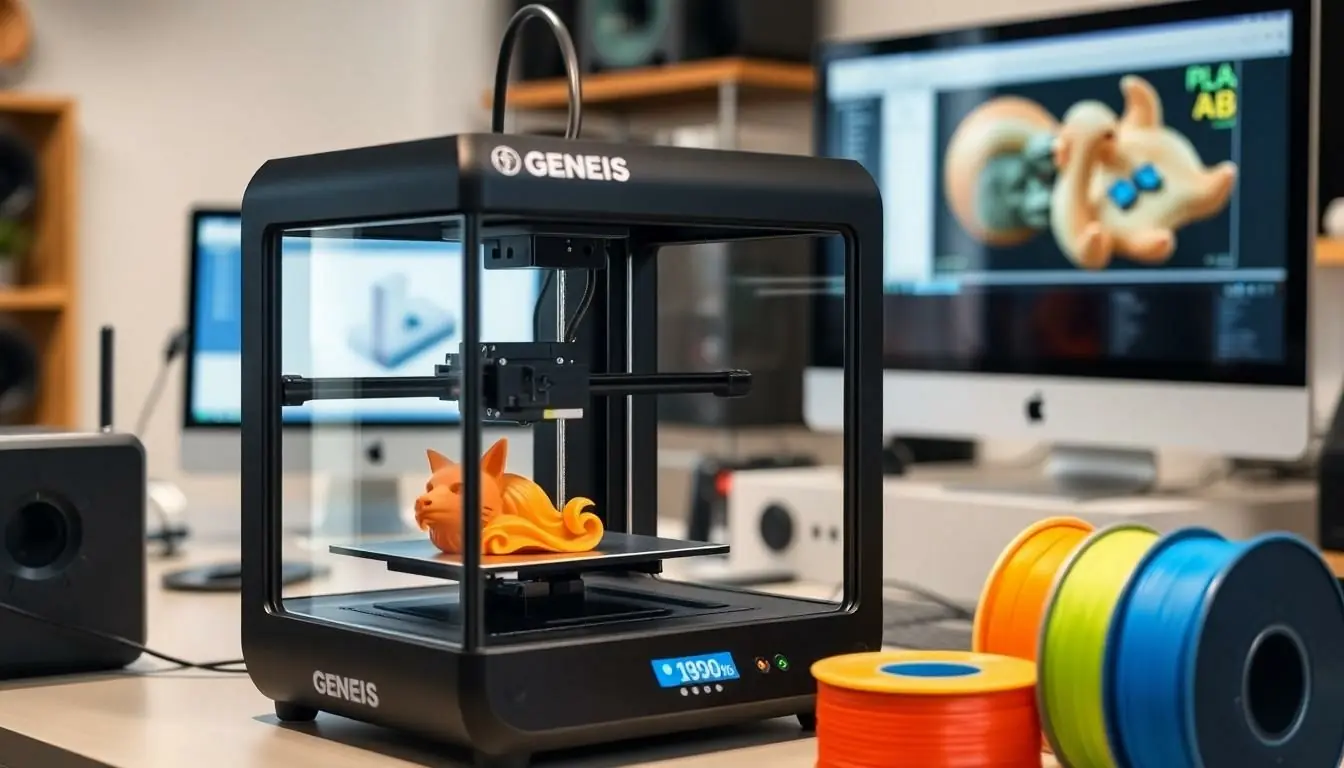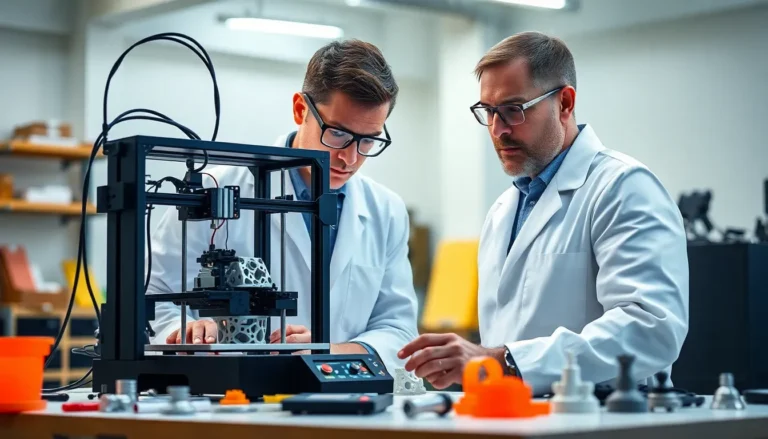In a world where creativity knows no bounds, Genesis 3D printing stands out like a unicorn at a horse show. This innovative technology isn’t just about making cool toys or funky trinkets; it’s revolutionizing industries from healthcare to aerospace. Imagine crafting intricate prototypes or even entire structures right from your desktop—it’s like having a mini factory in your home!
But wait, there’s more! With Genesis 3D printing, the only limit is your imagination. Whether you’re an artist, engineer, or just a curious soul, this technology opens doors to endless possibilities. So grab your ideas and get ready to watch them materialize in ways you never thought possible. Who knew that turning dreams into reality could be as easy as clicking a button?
Table of Contents
ToggleOverview of Genesis 3D Printing
Genesis 3D printing technology revolutionizes production across several fields, such as healthcare, aerospace, and education. This advanced system facilitates the creation of complex prototypes and functional components. Users can transform ideas into tangible products directly from their homes, mimicking a personal manufacturing facility.
Healthcare professionals utilize Genesis 3D printing for custom prosthetics, surgical models, and patient-specific tools. Aerospace engineers rely on its precision to produce lightweight components that enhance fuel efficiency and performance. Educational institutions adopt the technology to inspire students, enabling hands-on learning experiences.
Many artists embrace Genesis 3D printing as a medium for their creative expressions. Designers explore unique forms and materials, pushing the boundaries of traditional crafting methods. The only limit encountered is the imagination of the creator, allowing for endless innovative possibilities.
Affordability remains a significant advantage, as the cost of entry has decreased significantly over the years. Various models cater to different needs, making it accessible for hobbyists and professionals alike. The software that accompanies these printers often includes user-friendly interfaces, simplifying the design process.
Collaborative platforms for 3D models enhance the community aspect of Genesis 3D printing. Users can share designs, collaborate on projects, and contribute to open-source resources. This collective approach fosters a culture of innovation, making cutting-edge technology available to anyone eager to explore their creativity.
Key Features of Genesis 3D Printing

Genesis 3D printing offers an array of features that enhance its functionality across various applications.
Printer Specifications
Genesis printers boast impressive specifications. Build volumes vary, with options ranging from compact sizes to larger formats suitable for extensive projects. Print resolutions frequently achieve high levels of detail, ensuring precision in production. Materials compatibility includes a diverse selection like PLA, ABS, and specialty filaments, enabling versatility in design. Heated beds aid in adhesion and reduce warping, supporting consistent output quality. Speed settings allow users to adjust print durations based on project requirements, offering flexibility in operation.
Software Compatibility
Software compatibility represents a crucial aspect of Genesis 3D printing. Most Genesis printers support popular design programs such as Tinkercad, Fusion 360, and Cura, catering to different skill levels. Intuitive interfaces simplify the transition from concept to creation. Many integrated tools streamline design modifications and provide helpful guides throughout the process. Remote access capabilities enable users to monitor their prints in real-time. Regular updates ensure that the software stays current with evolving industry standards, enhancing overall efficiency.
Applications of Genesis 3D Printing
Genesis 3D printing technology demonstrates versatility through various applications across multiple sectors. It seamlessly blends creativity and function, bringing innovative solutions to the forefront.
Industrial Use Cases
Manufacturers employ Genesis 3D printing for rapid prototyping and production. Custom tooling emerges as a common necessity, allowing for reduced lead times and cost savings. Businesses utilize this technology to create lightweight aerospace components that contribute to enhanced performance and fuel efficiency. Medical device companies integrate the technology for the production of bespoke prosthetics and surgical instruments, tailored to individual patient needs. Production workflows improve significantly, leading to greater productivity and efficiency in industrial environments.
Educational Applications
Educational institutions leverage Genesis 3D printing to enhance hands-on learning experiences. Students design and create prototypes, developing critical skills in engineering and design. This technology cultivates creativity among young minds, inspiring them to explore various materials and methods. Collaborative projects in classrooms foster teamwork and problem-solving abilities, as students work together on design challenges. Additionally, educators utilize the technology in STEM programs to prepare students for future careers in innovative industries.
Advantages of Genesis 3D Printing
Genesis 3D printing offers numerous advantages that enhance its appeal across industries. First, affordability plays a crucial role in its accessibility. As the cost of entry decreases, more individuals can engage with this innovative technology. Enhanced user experience also arises from software with intuitive interfaces that simplify the design process.
Speed is another advantage, as Genesis 3D printers enable rapid prototyping and production. Projects that once took weeks can now be completed in days, significantly reducing time to market. Precision is paramount in applications like healthcare and aerospace, where high accuracy ensures that each prototype meets the required specifications.
Versatility stands out, with applications ranging from custom prosthetics to lightweight aerospace components. Diverse materials like PLA and ABS allow users to choose the best fit for their projects. This flexibility extends to educational settings where students develop their engineering skills as they interact with various design challenges.
Collaboration flourishes in the Genesis 3D printing community. Users frequently share designs and ideas through collaborative platforms, leading to innovative projects. Open-source resources contribute to this culture, promoting shared learning and creativity.
Lastly, regular software updates keep Genesis 3D printers aligned with industry standards. Staying up to date ensures that users can leverage the latest features and improvements. Each of these advantages reinforces Genesis 3D printing as a transformative tool for hobbyists and professionals alike, turning creative ideas into tangible objects with ease.
Considerations and Limitations
Genesis 3D printing technology presents several considerations and limitations across its applications. One major factor is the material constraints inherent to the process. While options like PLA and ABS are widely used, certain specialized materials might not be compatible, hindering specific projects.
Complexity of designs also plays a critical role. Intricate geometries may encounter difficulties during printing, potentially resulting in failures or defects. Users must evaluate their design complexities against the printer’s capabilities to ensure successful outcomes.
Another limitation lies in the finish quality of printed parts. Surface textures may require post-processing to achieve the desired aesthetics or functionality. This need can extend project timelines and increase labor costs for professional users.
Speed is a vital consideration as well. Though Genesis printers offer rapid prototyping capabilities, print times can vary depending on the complexity of the model and print settings. Users seeking quick turnarounds should account for these variables.
User familiarity with software also affects the printing process. While Genesis printers integrate with user-friendly design platforms, individuals lacking experience may struggle with advanced features. Understanding software fundamentals enhances overall project success.
Finally, costs can escalate unexpectedly. Although the entry point is lower than before, ongoing expenses for materials, maintenance, and software can accumulate. Budgeting for these factors ensures sustainable long-term use.
Awareness of these considerations empowers users to maximize the potential of Genesis 3D printing while navigating its limitations efficiently.
Genesis 3D printing stands as a groundbreaking technology that reshapes how individuals and industries approach design and production. Its ability to foster creativity and innovation is unparalleled, making it a valuable asset for professionals and hobbyists alike.
With its affordability and user-friendly features, Genesis 3D printing opens doors to endless possibilities in various fields. As users explore its capabilities, they can create intricate designs that were once only dreams.
While challenges exist, understanding these limitations allows users to navigate the technology effectively. Embracing Genesis 3D printing not only enhances productivity but also cultivates a vibrant community where ideas flourish and collaboration thrives.



